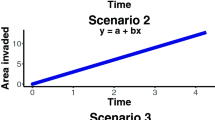Abstract
There has been a great deal of disagreement surrounding the capacity of Bombus terrestris to invade Tasmanian native vegetation. This paper reviews the conflicting findings of previous surveys of the invasion of Tasmania by B. terrestris, and presents new data from the 2004–2005 austral summer. From this, it is clear that B. terrestris has extensively invaded Tasmanian native vegetation. The new data provide strong evidence that B. terrestris is breeding in native vegetation in every region of Tasmania. More than 10 bumblebees were seen in one day at 153 locations in native vegetation, including 42 locations within 10 National Parks and 38 locations within the Tasmanian Wilderness World Heritage Area. Nests of B. terrestris were also found within two National Parks. These findings suggest that B. terrestris would also invade native vegetation in non-arid temperate regions of the Australian mainland, if it is introduced there.
Similar content being viewed by others
References
S. Carruthers (2003) ArticleTitlePlight of the bumblebee Pract. Hydroponics Greenhouses 69 24–30
S. Carruthers (2004) ArticleTitleA bee’s eye view Pract. Hydroponics Greenhouses 77 24–28
S.A. Cunningham F. FitzGibbon T.A. Heard (2002) ArticleTitleThe future of pollinators for Australian agriculture Aust. J. Agric. Res. 53 893–900 Occurrence Handle10.1071/AR01186
Goodwin S. and Steiner M. 1997. Introduction of Bombus terrestris for pollination of horticultural crops in Australia. A submission to AQIS and Environment Australia. Available from: http://www.tmag.tas.gov.au/workshop/append2.html
D. Goulson J.C. Stout A.R. Kells (2002) ArticleTitleDo exotic bumblebees and honeybees compete with native flower-visiting insects in Tasmania? J. Ins. Conserv. 6 179–189 Occurrence Handle10.1023/A:1023239221447
K. Hergstrom R. Buttermore (1999) Have you seen any bumblebees in Tasmania? Tasmanian Museum and Art Gallery Hobart
Hergstrom K., Buttermore R., Seeman O. and McCorkell B. 2002. Environmental Research on the Impact of Bumblebees in Australia and Facilitation of National Communication for/against Further Introduction. Horticulture Australia Project No: VG99033.
A.B. Hingston (2005a) ArticleTitleInbreeding in the introduced Bumblebee Bombus terrestris causes uncertainty in predictions of impacts on native ecosystems Ecol. Manage. Rest. 6 151–153 Occurrence Handle10.1111/j.1442-8903.2005.230-8.x
A.B. Hingston (2005b) ArticleTitleDoes the introduced bumblebeeBombus terrestris (Apidae), prefer flowers of introduced or native plants in Australia? Aust. J. Zool. 53 29–34 Occurrence Handle10.1071/ZO04048
A.B. Hingston P.B. McQuillan (1998) ArticleTitleDoes the recently introduced bumblebee Bombus terrestris (Apidae) threaten Australian ecosystems? Aust. J. Ecol. 23 539–549
A.B. Hingston J. Marsden-Smedley D.A. Driscoll S. Corbett J. Fenton R. Anderson et al. (2002) ArticleTitleExtent of invasion of Tasmanian native vegetation by the exotic bumblebee Bombus terrestris (Apoidea: Apidae) Aust. Ecol. 27 162–172 Occurrence Handle10.1046/j.1442-9993.2002.01179.x
A.B. Hingston W. Herrmann G.J. Jordan (2006) ArticleTitleReproductive success of a colony of the introduced bumblebee Bombus terrestris (L.) (Hymenoptera: Apidae) in a Tasmanian National Park. Aust. J. Entomol. 45 137–141 Occurrence Handle10.1111/j.1440-6055.2006.00527.x
N. Inari T. Nagamitsu T. Kenta K. Goka T. Hiura (2005) ArticleTitleSpatial and temporal pattern of introduced Bombus terrestris abundance in Hokkaido, Japan, and its potential impact on native bumblebees Popul. Ecol. 47 77–82 Occurrence Handle10.1007/s10144-004-0205-9
T.C. Ings J. Schikora L. Chittka (2005) ArticleTitleBumblebees, humble pollinators or assiduous invaders? A population comparison of foraging performance in Bombus terrestris Oecologia 144 508–516 Occurrence Handle15891827 Occurrence Handle10.1007/s00442-005-0081-9
D. Kreyer A. Oed K. Walther-Hellwig R. Frankl (2004) ArticleTitleAre forests potential barriers for foraging bumblebees? Landscape scale experiments with Bombus terrestris agg. and Bombus pascuorum (Hymenoptera: Apidae) Biol. Conserv. 116 111–118 Occurrence Handle10.1016/S0006-3207(03)00182-4
C. Matsumara J. Yokoyama I. Washitani (2004) ArticleTitleInvasion status and potential ecological impacts of an invasive alien bumblebeeBombus terrestris L. (Hymenoptera: Apidae) naturalized in southern HokkaidoJapan Glob. Env. Res. 8 51–66
T. Semmens (1995) ArticleTitleThe buzzzzz on bumble bees! Agric. Tas. 1 19
J.C. Stout D. Goulson (2000) ArticleTitleBumblebees in Tasmania: their distribution and potential impact on Australian flora and fauna Bee World 81 80–86
Author information
Authors and Affiliations
Corresponding author
Rights and permissions
About this article
Cite this article
Hingston, A.B. Is the exotic bumblebee Bombus terrestris really invading Tasmanian native vegetation?. J Insect Conserv 10, 289–293 (2006). https://doi.org/10.1007/s10841-006-6711-7
Received:
Accepted:
Issue Date:
DOI: https://doi.org/10.1007/s10841-006-6711-7




